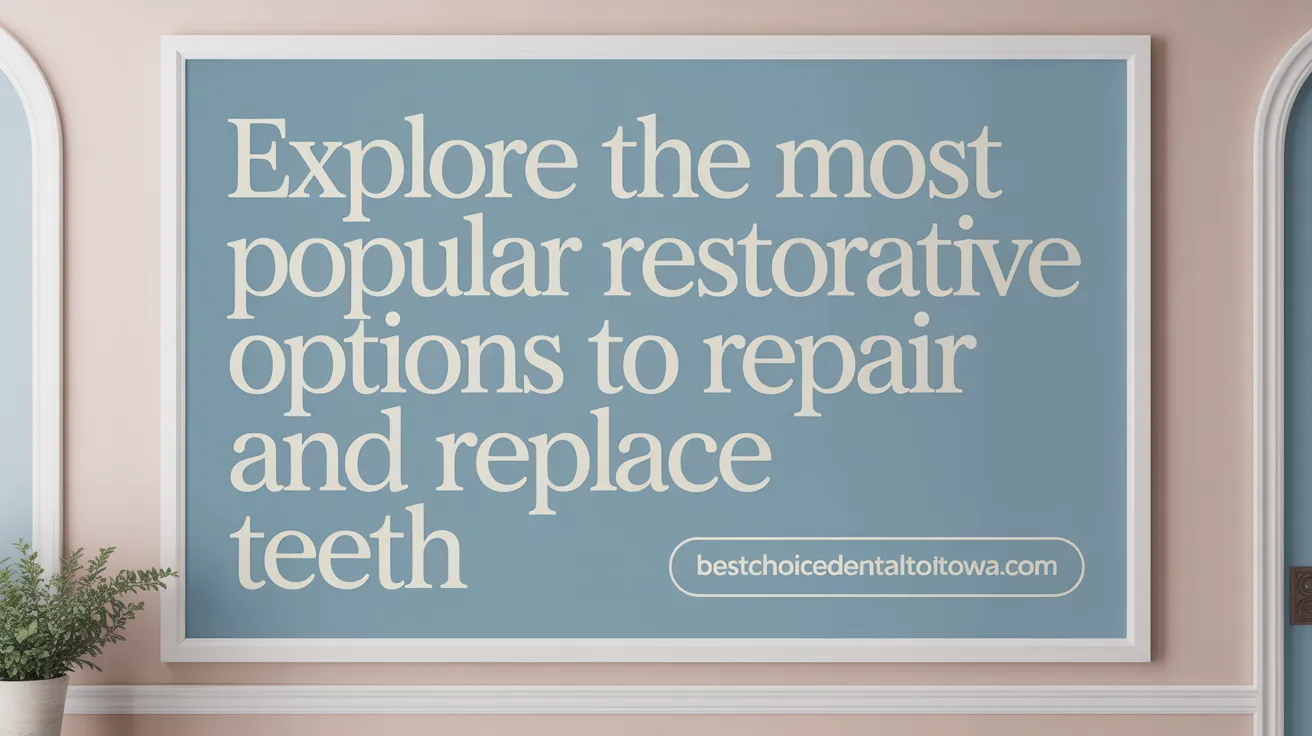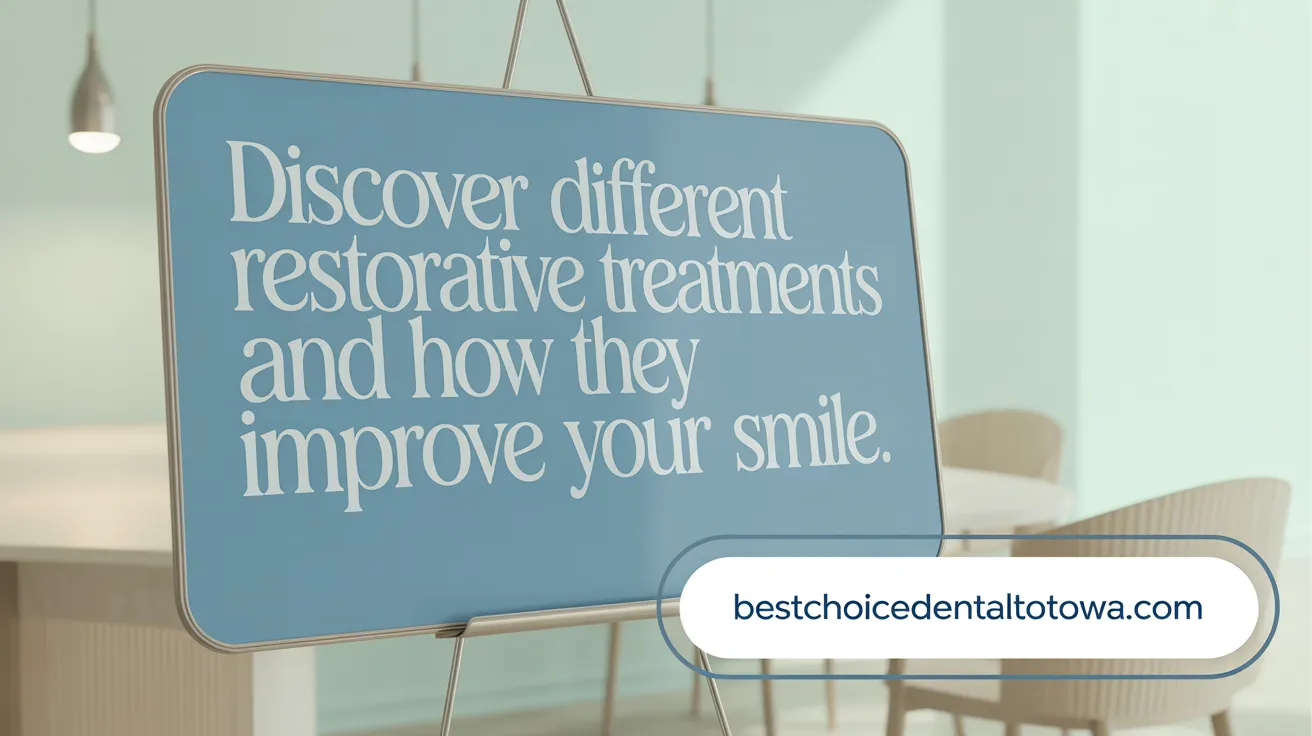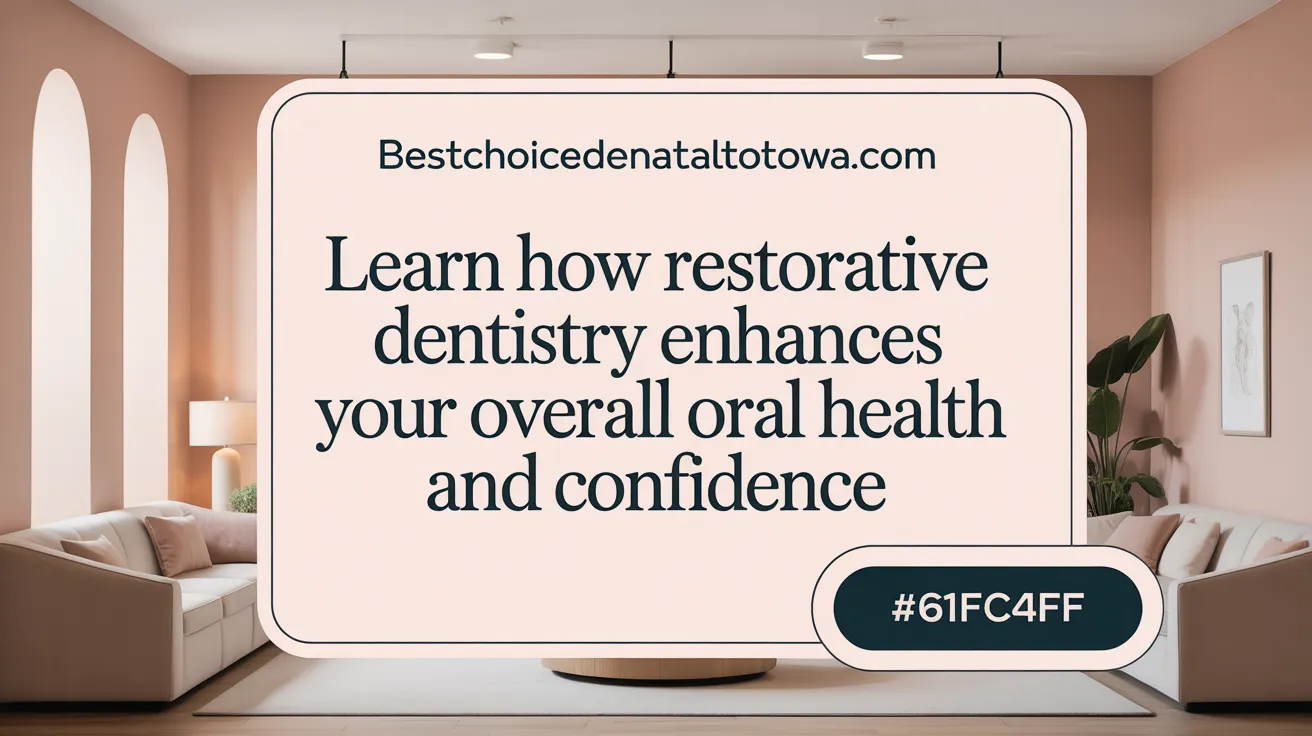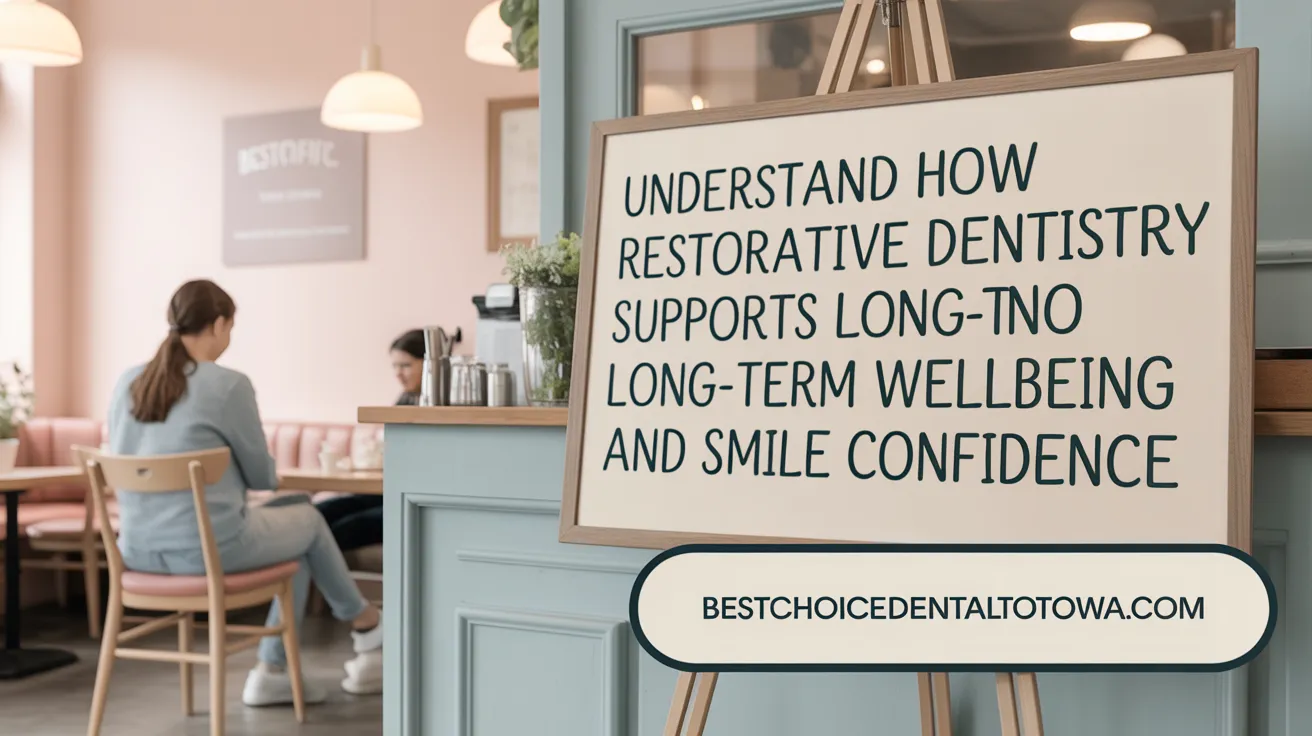Introduction to Restorative Dentistry
Restorative dentistry is a vital branch of dental care focused on repairing and replacing damaged or missing teeth, thereby enhancing oral health, function, and appearance. This introduction explores the fundamental goals of restorative dentistry and its critical role in maintaining a healthy smile, improving chewing and speaking abilities, preventing future dental complications, and boosting patient confidence and quality of life.
Common Restorative Dentistry Procedures and Their Purposes

What are the common options available in restorative dentistry for maintaining or improving oral health?
Restorative dentistry provides a wide array of treatments to repair or replace damaged, decayed, or missing teeth, ultimately promoting better oral health and improved function. The most commonly used procedures include dental fillings, crowns, bridges, implants, and dentures.
Dental fillings are used to repair cavities caused by decay and restore the tooth's shape. Crowns are custom-made caps that reinforce and protect damaged teeth, restoring their strength and appearance. Bridges are fixed prostheses that fill gaps created by missing teeth, anchored to neighboring teeth. Dental implants act as artificial roots surgically placed into the jawbone to support crowns or bridges, offering a permanent solution. Dentures serve as removable replacements for multiple missing teeth, improving both function and aesthetics.
Other procedures like inlays and onlays provide conservative restorations for larger cavities that do not require full crowns, constructed from porcelain or resin. Root canal therapy removes infected tissue from the tooth pulp, preventing extraction and restoring function.
These treatment options work together to restore the ability to chew, speak confidently, and smile, while also preventing further decay and structural damage. Regular dental visits and good oral hygiene are essential to maintain the longevity of these restorations, ensuring ongoing oral health and function.
Types of Restorative Dentistry Treatments and Their Specific Roles

What types of restorative dental procedures are there and what purposes do they serve?
Restorative dentistry offers various treatments tailored to repair or replace damaged or missing teeth, thereby improving overall oral health and functionality.
Dental fillings are used to treat cavities by filling decayed areas with materials like amalgam, composite resin, or gold. They restore the tooth's shape and strength.
Crowns and bridges are designed to protect and strengthen damaged teeth (crowns) and fill gaps where teeth are missing (bridges). Crowns can be made from all-ceramic, porcelain-fused-to-metal (PFM), or metal materials, ensuring durability and aesthetic appeal.
Dental implants act as a permanent solution for missing teeth. They involve surgically inserting a titanium post into the jawbone, which supports a crown, bridge, or denture, mimicking natural tooth roots.
Inlays and onlays are conservative restorations used when decay or damage is moderate. Made from porcelain, resin, or gold, they fit within the tooth structure and provide a durable, natural-looking repair.
Root canal therapy removes infected pulp within a damaged or decayed tooth, preventing further infection and saving the natural tooth.
These treatments serve multiple purposes: restoring chewing ability, eliminating pain, preventing further dental issues, and enhancing appearance. With proper maintenance, many of these procedures can last for years, contributing significantly to better oral health and quality of life.
Benefits of Restorative Dentistry for a Healthy Smile

What are the benefits of different restorative treatments for achieving a healthy smile?
Restorative dentistry offers a range of treatments that significantly improve oral health and appearance. These procedures are designed to repair damaged or decayed teeth, helping prevent additional issues like cavities, infections, or further deterioration.
By restoring tooth structure and function, treatments such as crowns, fillings, bridges, and implants enable patients to chew, speak, and enjoy a healthy diet comfortably. They also support jawbone health by preserving or replacing tooth roots, especially with implants.
Beyond functionality, restorative dentistry enhances smile aesthetics—covering concerns like discoloration, chips, or gaps with veneers, crowns, or bridges. This boost in appearance often leads to increased confidence and emotional well-being.
In summary, these treatments not only address immediate dental problems but also promote long-term health, reduce pain, and improve overall quality of life. Regular dental care and timely interventions are essential for maximizing these benefits.
Factors to Consider When Choosing Restorative Dentistry Options
What factors should be considered when choosing restorative dentistry options?
Selecting the right restorative dental treatment depends on several important considerations. First, the patient's age and overall health are vital; younger and healthier individuals often opt for durable solutions like dental implants, while older adults may find dentures more suitable.
The extent of tooth damage or missing teeth is also crucial. For instance, minor cavities might be treated with fillings, while severely damaged teeth may require crowns or even tooth extraction followed by implants or bridges.
Another essential factor is the condition of the jawbone. Adequate bone density is necessary for implant placement. If the jawbone is weak or deteriorated, procedures like bone grafting may be needed beforehand.
Cost and insurance coverage can significantly influence decision-making. While some procedures like fillings are affordable, others like dental implants can be costly but may be covered by insurance if deemed medically necessary.
Personal preferences and lifestyle choices should also be considered, including the desire for non-invasive options, maintenance requirements, and aesthetic preferences. Patients with underlying health conditions, such as diabetes or osteoporosis, should consult their dentist, as these conditions can affect healing and the success of certain procedures.
Ultimately, a thorough evaluation by a qualified dentist is essential. They will assess clinical factors, discuss treatment options, and tailor interventions to align with the patient's health, needs, and goals.
Contribution of Restorative Dentistry to Overall Oral Health and Quality of Life

How do restorative treatments contribute to overall oral health and quality of life?
Restorative dentistry plays a crucial role in maintaining and improving oral health by repairing damaged, decayed, or missing teeth. Procedures like fillings, crowns, and implants help prevent the progression of dental issues such as cavities, infections, and gum disease. These treatments not only restore the teeth’s structure but also reduce the risk of systemic health problems like heart disease and diabetes, which are linked to oral infections.
By restoring essential functions such as chewing and speaking, restorative dentistry enhances daily activities. When patients can chew properly, they enjoy better nutrition, which supports overall health and well-being. Clear speech aids in effective communication, boosting confidence and social interaction.
Beyond functionality, restoring the appearance of teeth can significantly boost self-esteem. Improved smile aesthetics often lead to greater social confidence, helping individuals feel more comfortable in personal and professional settings.
Routine dental visits and proper oral hygiene practices are vital for prolonging the benefits of restorative treatments. Regular check-ups allow early detection of potential problems, ensuring long-lasting results.
In summary, restorative dentistry significantly contributes to overall health and quality of life. It promotes physical health by preventing disease, supports emotional well-being through improved appearance, and enhances social confidence by restoring function and aesthetic appeal.
| Aspect | Benefits | Additional Details |
|---|---|---|
| Prevention of further oral diseases | Stops decay, infections | Reduces risk of systemic health issues |
| Restoration of chewing and speaking abilities | Improved eating and communication | Supports better nutrition and social interactions |
| Improvement of nutrition and well-being | Balanced diet with proper chewing | Enhances overall health |
| Boosting self-esteem and confidence | Aesthetic smile and better self-image | Encourages social participation |
| Role in systemic health | Prevents linkages with heart and diabetes | Maintains overall health |
Understanding how restorative treatments foster health can guide patients toward timely and effective care, resulting in a better quality of life.
Advanced Technologies Enhancing Restorative Dentistry Outcomes
Modern advancements in technology are transforming restorative dentistry, making procedures more precise, comfortable, and efficient. One such innovation is the use of 3D cone beam CT scans, which provide detailed imaging of the jawbone and teeth. This allows dentists to plan treatments with greater accuracy, especially for implants and complex reconstructions.
Digital impressions have replaced traditional molds, offering quicker and more comfortable experiences for patients. These high-tech images enable precise fabrication of crowns, bridges, and other restorations, reducing errors and treatment time.
Laser dentistry is another breakthrough that minimizes discomfort and enhances healing. Lasers are used for procedures like soft tissue treatments and cavity removal, often resulting in less bleeding, reduced need for anesthesia, and quicker recovery.
Telehealth has become increasingly valuable in the planning and monitoring of restorative treatments. Virtual consultations allow patients to discuss options and receive professional guidance without the need for multiple in-office visits, improving accessibility and convenience.
Overall, these modern technologies improve the precision of procedures, increase patient comfort, and lead to better long-term outcomes in restorative dentistry, ultimately helping individuals regain healthy, functional, and aesthetically pleasing smiles.
Maintenance and Longevity of Restorative Treatments
Importance of good oral hygiene
Maintaining excellent oral hygiene is essential for the longevity of restorative dental treatments. Brushing twice daily, flossing regularly, and using mouthwash help keep the teeth and gums healthy, preventing decay and infection that can compromise restorations.
Routine dental visits
Regular dental check-ups are vital for monitoring the condition of restorations like crowns, fillings, or implants. Dentists can detect early signs of wear, damage, or loosening, allowing timely intervention before issues develop further.
Avoidance of harmful habits
Avoiding habits like biting hard objects, grinding teeth, smoking, and consuming excessive sugary or acidic foods extends the lifespan of restorations. These habits can cause undue stress or damage, leading to costly repairs or replacements.
Signs of restoration problems
Patients should watch for signs such as sensitivity, discomfort, visible damage, or a restoration feeling off. Prompt visits to the dentist at the first sign of trouble can prevent more severe problems and ensure restorations remain effective and durable.
Role of dentist consultation for longevity
Scheduled visits and open communication with a restorative dentist help ensure treatments last longer. Dentists can provide personalized advice, perform necessary adjustments, and recommend maintenance strategies tailored to individual needs.
| Aspect | Tips/Details | Why It Matters |
|---|---|---|
| Oral Hygiene | Brush, floss, use mouthwash regularly | Prevents decay, infection, and buildup |
| Dental Check-ups | Biannual visits or as advised by your dentist | Early detection of issues, prolongs treatment life |
| Avoid Harmful Habits | No biting hard objects, quit smoking, limit sugary foods | Reduces risk of damage and decay |
| Recognize Problems | Sensitivity, pain, cracks, loose restorations | Quick response prevents extensive repair needs |
| Dentist Consultations | Follow-up appointments, professional advice on care | Maintains the function and appearance of restorations |
Conclusion: Choosing the Right Restorative Dentistry Path
Restorative dentistry provides a comprehensive range of treatments designed to repair and replace damaged or missing teeth, significantly improving oral health, function, and appearance. By understanding the variety of available procedures—from fillings and crowns to implants and dentures—patients can make informed decisions tailored to their individual needs and circumstances. Considering personal health, extent of dental damage, and lifestyle factors ensures optimal treatment outcomes. Technological advances continue to enhance the precision and comfort of restorative care, while diligent maintenance promotes the longevity of these treatments. Ultimately, restorative dentistry not only restores smiles but also elevates overall quality of life through improved nutrition, communication, and confidence. Consulting with a qualified restorative dentist is essential to achieve the best, lasting results for a healthy, radiant smile.
References
- Restorative Dentistry: What It Is, Types & Procedures
- Restorative Dentistry: Options for Restoring Your Smile
- Restorative Dentistry 101: Understanding Your Options
- Understanding Restorative Dentistry: Options and Benefits
- Top 5 Restorative Dentistry Procedures for a Healthy, ...
- How Restorative Dentistry Can Improve Your Quality of Life
- A Comprehensive Overview of Restorative Dentistry ...
- Restorative Dentistry: What It Is, Types & Procedures
